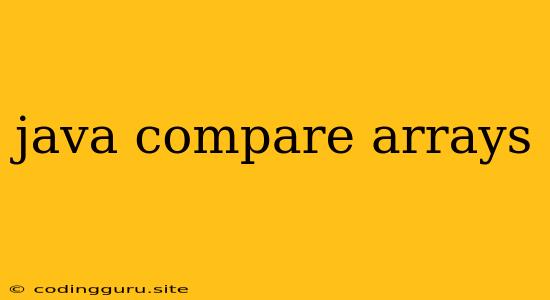Comparing Arrays in Java
Arrays are fundamental data structures in Java, and comparing them effectively is a common task in various programming scenarios. This article will delve into the intricacies of comparing arrays in Java, exploring different approaches and scenarios to help you navigate this process effectively.
Understanding Array Equality
Before diving into comparison techniques, it's crucial to grasp the concept of array equality in Java. Java doesn't directly support comparing arrays using the == operator for content equality. This operator checks if two array references point to the same memory location, not whether the array elements are identical. To compare arrays based on their content, you need to employ specific methods or algorithms.
Methods for Comparing Arrays
Several methods and techniques can be employed to compare arrays in Java. Let's explore the most common and effective approaches:
1. Using the Arrays.equals() Method:
The Arrays.equals() method from the java.util.Arrays class provides a convenient way to compare two arrays for content equality. This method is designed to handle both primitive and object arrays.
Example:
int[] array1 = {1, 2, 3};
int[] array2 = {1, 2, 3};
boolean isEqual = Arrays.equals(array1, array2); // true
String[] strArray1 = {"Apple", "Banana", "Cherry"};
String[] strArray2 = {"Apple", "Banana", "Cherry"};
boolean strEquals = Arrays.equals(strArray1, strArray2); // true
2. Iterating Through Arrays:
For more customized comparison scenarios, you can iterate through the elements of both arrays and compare them individually. This approach grants you flexibility to implement specific comparison logic for each element.
Example:
int[] array1 = {1, 2, 3};
int[] array2 = {1, 2, 3};
boolean isEqual = true;
if (array1.length != array2.length) {
isEqual = false;
} else {
for (int i = 0; i < array1.length; i++) {
if (array1[i] != array2[i]) {
isEqual = false;
break;
}
}
}
3. Using Stream API:
Java 8 introduced the Stream API, providing a functional approach to array manipulation. You can utilize streams to compare arrays by combining elements and applying comparison logic.
Example:
int[] array1 = {1, 2, 3};
int[] array2 = {1, 2, 3};
boolean isEqual = IntStream.range(0, array1.length)
.allMatch(i -> array1[i] == array2[i]); // true
Comparing Arrays with Different Data Types
When comparing arrays of different data types, you need to ensure that the comparison logic is aligned with the underlying data structures. For example, comparing arrays of Integer and String would require explicit casting or type conversion.
Example:
Integer[] intArray = {1, 2, 3};
String[] strArray = {"1", "2", "3"};
// Incorrect comparison
boolean isEqual = Arrays.equals(intArray, strArray); // false
// Correct comparison with explicit casting
boolean isEqual = IntStream.range(0, intArray.length)
.allMatch(i -> intArray[i].equals(Integer.parseInt(strArray[i]))); // true
Comparing Arrays for Partial Equality
In some cases, you might need to check if arrays share a subset of elements or if they are partially equal. For such scenarios, you can leverage custom comparison algorithms or use methods like Arrays.copyOfRange() to extract specific portions of the arrays for comparison.
Example:
int[] array1 = {1, 2, 3, 4, 5};
int[] array2 = {2, 3, 4};
// Checking if array2 is a subset of array1
boolean isSubset = IntStream.range(0, array2.length)
.allMatch(i -> Arrays.asList(array1).contains(array2[i])); // true
Important Considerations
- Object Arrays: When comparing object arrays, remember that
Arrays.equals()uses the object'sequals()method for comparison. Ensure your custom objects correctly override theequals()method to ensure accurate comparison. - Performance: While iterating through arrays is efficient, the
Arrays.equals()method is generally more optimized. Consider usingArrays.equals()whenever possible for performance gains.
Conclusion
Comparing arrays in Java is a fundamental operation with multiple approaches available. The appropriate method depends on the specific comparison scenario and the desired level of control. Understanding the different techniques, especially the differences between comparing arrays by reference and comparing their contents, will empower you to effectively compare arrays in your Java projects.
